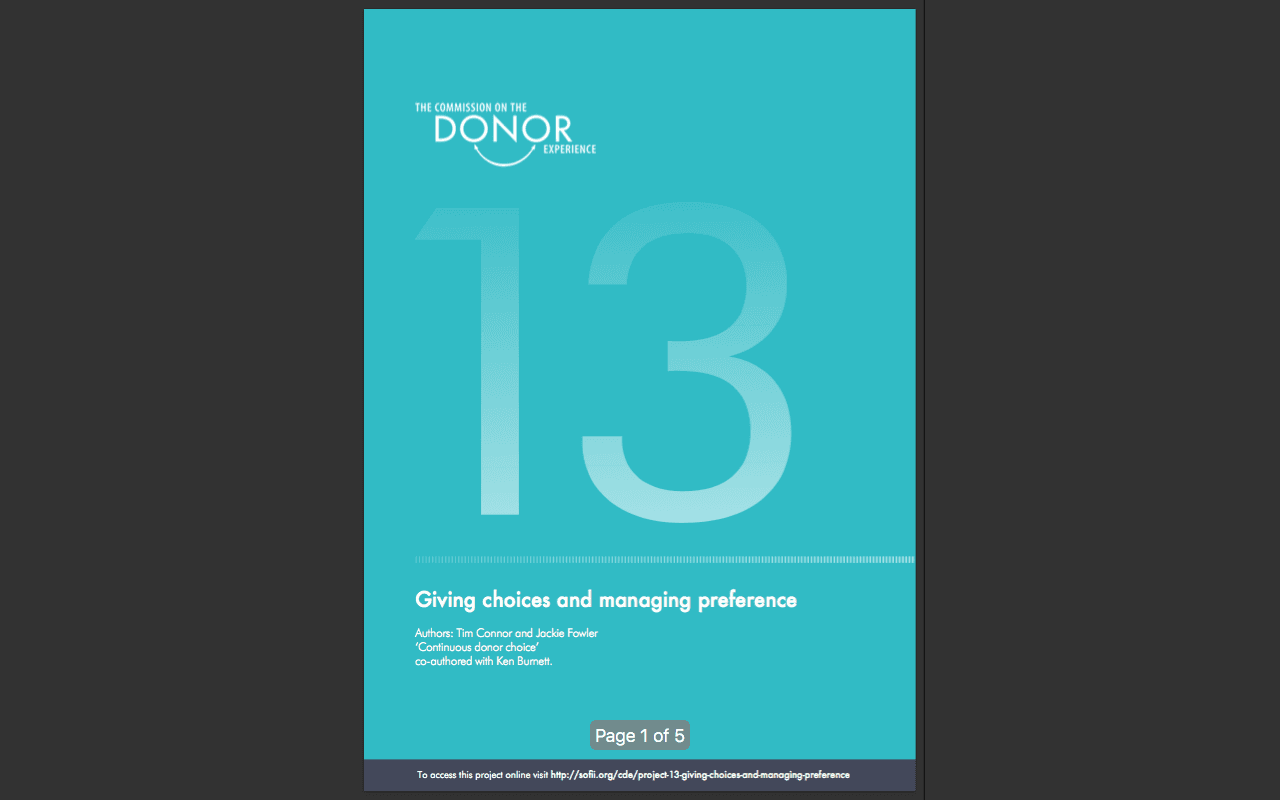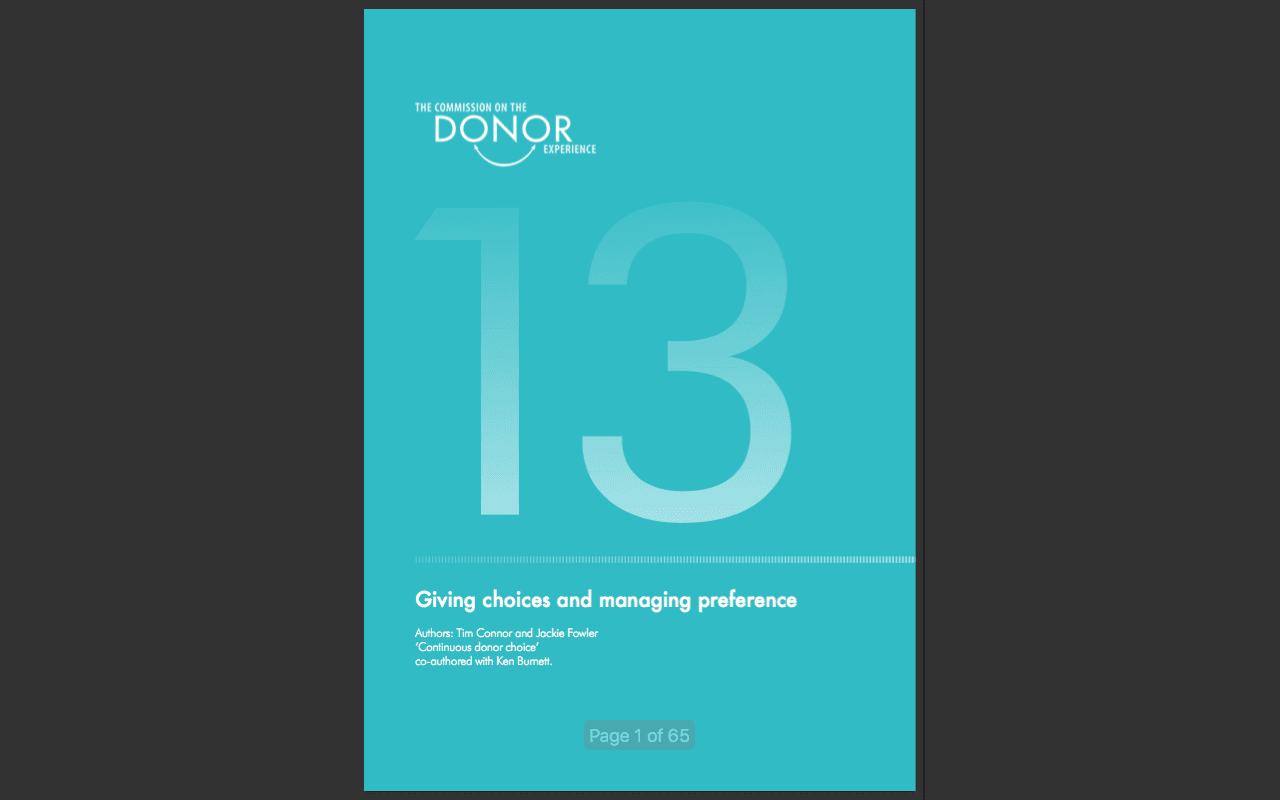CDE project 13 section 1 summary: giving choices and managing preference
- Written by
- The Commission on the Donor Experience
- Added
- May 01, 2017
Giving choices and managing preference
Authors: Tim Connor and Jackie Fowler
‘Continuous donor choice’ co-authored with Ken Burnett
Project Brief
Whether or not charities will be obliged to offer the public choices, there is clear evidence that giving donors practical control over how they relate to and hear from fundraisers can be highly effective in improving the donor experience. This project will look at the systems that have been implemented, how they work and the results they’ve achieved, with the aim of defining an ideal approach that offers donors practical choices and real control over the shape of their relationship with individual causes.
For senior management and trustee boards, this project will:
- Explain why it may be beneficial to work from a perspective of ‘How can we find out what donors want, and use communications to better anticipate what donors would like to receive, and give them choices to meet their needs, so that they get a great experience of being a supporter?’
- Show them how fundraisers should use communications to deliver a rewarding relationship which puts donors in control and builds their trust, offering choice and control.
- Explain how they can give donors options of different channels of communication, different amounts of communication, different types of information or communication, and different timings. Understand how offering choices and managing preferences becomes a very valuable way of building donor satisfaction, trust and loyalty.
For donors, this project will:
- Stop them feeling out of control, and receiving communications they don’t want. This will reduce feelings of annoyance, being put upon and taken for granted.
- Build trust by making communications more about what matters to them and less of what doesn’t.
- Make it easy for them to contact a charity to express their preferences and feedback.
Summary Guidance
Why give donors choice and control?
Donors want more choice and control over what they receive, when, how much, and through what channel. Compelling evidence from wide-ranging research shows this makes donors feel more positively about your cause and more inclined to give (and stay). It will lead to greater trust, more goodwill and commitment, and greater respect for your charity.
However, fundraisers are also working in an environment where donors are increasingly concerned about data security, sharing of data, and over contact. Feeling out of control, and receiving communications they don’t want, can lead to feelings of annoyance, being put upon and taken for granted, and can lead to loss of support.
A better place to start
Research reviewed for this project, and best practice reviewed, puts the onus instead on an open, listening relationship with donors where the charity is always working from a perspective of ‘How can we find out what donors want, and use communications to better anticipate what donors would like to receive, and give them choices to meet their needs, so that they get a great experience of being a supporter?’
Where charities begin with the donors’ perspective, and set out to use communications to deliver a rewarding relationship which puts donors in control and builds their trust, offering choice and control, is a key part of overcoming donors’ concerns as outlined above.
What sort of choices can charities offer?
Charities can give donors options of different channels of communication, different amounts of communication, different types of information or communication, and different timings.
Donors can also be invited to choose between different types of engagement. They can be given choices about the way they support (for example different fundraising ‘products’, or whether to take part in an event, volunteer etc). They can be offered the chance to attend events. They can be invited to engage in a more personal way by, for example, sending a personal message, linking with a particular project or individual, or choosing to support an aspect of work that is close to their heart.
In all the examples we have seen, charities build trust when they start by thinking of it from the donor’s perspective: what would make the experience of giving more fulfilling, interesting, enriching etc? How can I give donors more of what matters to them, and less of what they don’t want?
Once you think of it from this perspective, offering choices and managing preferences becomes a very valuable way of building donor satisfaction, trust and loyalty.
Charities that do this well are those that think in terms of investing in the overall, lifetime value of a donor’s support, rather than one year return on investment. It tends to come from a cultural perspective, and this is a shift that should be worked towards.
Everyone can take steps along the path to giving donors choice
Of course, different charities will have different levels of sophistication in terms of what they can offer, and what they fulfil. And the move to valuing donors at the heart of a charity is a longer-term shift that will take time.
But any charity can choose to adopt a series of principles:
- Explain to donors up front what supporting your charity will feel like from a communications perspective
- Be clear about how your charity treats its donors, and reassure them about what you do not do l Set out to create supporter journeys that put your donors, and what they are interested in, first
- Give donors choices where you can.
Whatever choices you offer, you need to be able to fulfil, and commit to fulfilling. This may limit what you can offer donors right away, but you can work in stages: for example, receive what we usually send (and quantify this), or hear less frequently, or not hear from us in future at all.
Communications will be most welcome to your donors where they are experienced as relevant and interesting to them. Where you have good reason to get in touch when you do, and a clear need to share. When the type and quantity of contact is felt to be reasonable. And where they trust you not to mis-use their information. Any charity should set out to meet these standards.
So, giving donors choices and managing their preferences is an important part of good donor stewardship, but within the context of a relationship that sets out to value donors as partners and treat them well.
Offering choices and managing preferences at a tactical level (you should be able to do at least some of these things straight away)
- Make it easy for people to contact you. Invite them to do so (e.g. on the bottom of a letter or on a reply form), in a warm and friendly way that shows you really welcome their contact. Share a phone number, the name and ideally photo of someone they can speak to, and an email address too. Reassure them they can raise any questions or queries, and that you are ready to hear from them.
- If you can, build an event to invite people closer to your cause, so you can show them your work, bring them closer to the cause and how you make a difference, answer questions and listen to what they have to say.
- Make opportunities to speak to your donors. Finding out about them and their concerns, and listening to their views and concerns, gives you the best guidance on how to create communications that will be welcome.
- Review all your donor recruitment literature/copy. How can you set out for a new donor (e.g. on a donor acquisition communication) what the relationship will feel like, and what sort of choices/control you can offer them, to reassure them that they will have a say in what follows, and that you will take note of what they want? What can you promise donors about how you will treat them (and how you won’t treat them)?
- Shift the focus from ‘we’ to ‘you’, but make it genuine, a shift of emphasis across every aspect of your communications – not a token language change.
- Use of language is critical. Write in a friendly, personal way, to the real person you are talking to. Be clear. Avoid jargon. Express it from their perspective (put them at the centre of the communication, not your charity and its needs.)
- Review all the donor touchpoints across your charity. To truly meet donors’ preferences and choices, all staff should be trained to encourage open feedback, note specific feedback, choices and preferences, and make sure these are actioned. To ask the right questions, listen and make each donor feel listened to.
A final word
Charities enjoy a great privilege – the opportunity to bring people close to causes they really care about; and to help people to bring about change that really matters to them, but which they cannot do alone.
Done well, fundraising can touch donors deeply: it can enable people to reach inside and express heartfelt values which may be born through personal experience. For donors, supporting a cause can be rewarding, it can bring pleasure, and joy.
With this privilege comes responsibility – to honour this special bond, to respect people as individuals with their own lives and reasons for giving, and to make the experience of supporting the charity that works with the cause they care about a positive and even life-enhancing one.
The dangers of taking this goodwill that donors offer for granted have come home to roost: many donors express feelings of annoyance and irritation; of being asked too often and contacted too much, in ways and with communications they don’t want; of being out of control, fed up, questioning why they give, and even withdrawing their support altogether.
Giving donors choices and managing their preferences puts donors back in control. It means donors can trust your charity, knowing the relationship will give them what they want, and not trespass on their goodwill. By acting on the findings of this project, your charity can work towards a place where listening, and offering different options and choices, can help shape the sort of relationship they experience. And donors can enjoy being donors.
It is just one part – but a very important part – of building long-lasting partnerships between donors and causes they care about that can offer great opportunities and real long-term value to both the donor and the charity.
See also on SOFII
Giving donors choices.
Botton Village: the Frances pack.



















